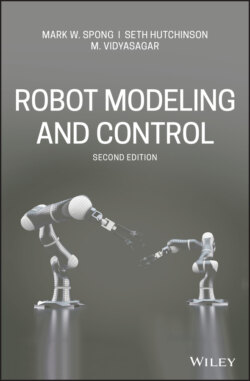Читать книгу Robot Modeling and Control - Mark W. Spong - Страница 72
2.7 Chapter Summary
ОглавлениеIn this chapter, we have seen how matrices in SE(n) can be used to represent the relative position and orientation of two coordinate frames for n = 2, 3. We have adopted a notional convention in which a superscript is used to indicate a reference frame. Thus, the notation represents the coordinates of the point p relative to frame 0.
The relative orientation of two coordinate frames can be specified by a rotation matrix, R ∈ SO(n), with n = 2, 3. In two dimensions, the orientation of frame 1 with respect to frame 0 is given by
in which θ is the angle between the two coordinate frames. In the three-dimensional case, the rotation matrix is given by
In each case, the columns of the rotation matrix are obtained by projecting an axis of the target frame (in this case, frame 1) onto the coordinate axes of the reference frame (in this case, frame 0).
The set of n × n rotation matrices is known as the special orthogonal group of order n, and is denoted by SO(n). An important property of these matrices is that R− 1 = RT for any R ∈ SO(n).
Rotation matrices can be used to perform coordinate transformations between frames that differ only in orientation. We derived rules for the composition of rotational transformations as
for the case where the second transformation, R, is performed relative to the current frame and
for the case where the second transformation, R, is performed relative to the fixed frame.
In the three-dimensional case, a rotation matrix can be parameterized using three angles. A common convention is to use the Euler angles (ϕ, θ, ψ), which correspond to successive rotations about the z, y, and z-axes. The corresponding rotation matrix is given by
Roll, pitch, and yaw angles are similar, except that the successive rotations are performed with respect to the fixed, world frame instead of being performed with respect to the current frame.
Homogeneous transformations combine rotation and translation. In the three-dimensional case, a homogeneous transformation has the form
The set of all such matrices comprises the set SE(3), and these matrices can be used to perform coordinate transformations, analogous to rotational transformations using rotation matrices.
Homogeneous transformation matrices can be used to perform coordinate transformations between frames that differ in orientation and translation. We derived rules for the composition of rotational transformations as
for the case where the second transformation, H, is performed relative to the current frame and
for the case where the second transformation, H, is performed relative to the fixed frame.
We also defined the vector spaces
and showed that elements of SO(3) and SE(3) can be expressed as matrix exponentials of elements of so(3) and se(3). Formally, SO(3) and SE(3) are Lie groups and so(3) and se(3) are their associated Lie algebras.
